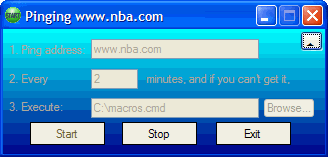
Let's say you leave your computer alone for a while, working on a task (uploading content to your site, downloading a large
VM appliance etc.). You return after a couple of hours to find out your computer disconnected from the internet and the entire job failed.
Or let's say you're like me, on the road 80% of your time. You leave your computer at home on - and connect to it from the road through
VNC. Only, if the computer disconnected from the internet, due to a DSL drop - you're screwed.
That was the problem I've encountered about a year ago: I was working in Europe, limited, in many places, to modem-speed connection. I therefore used it to connect to my home computer and order it to do the heavy lifting.
About once a week, my ISP dropped my DSL connection (I later found out it's their a policy: if you have a private account, you're not supposed to be connected 24X7 - because that would imply you're a business, and then you need to pay for a business account) and I could not connect to my computer until I returned home.
This pissed me off to no end for several months, until I decided to solve it. [Yes, this post's tool was written by me].
I wrote a small application called
Heartbeat Monitor that runs in the background (minimized to the tray) and pings a certain address (one that's supposed to be up 99.999% of the time, say www.google.com). If the ping operation failed, the program launched a script that called the internet dialer and resumed the connection. If it was an actual line problem, it would keep trying to run the script every
n minutes. Eventually, it resumed the internet connection (unless there was a complete power failure) and I could reach my computer again.
The application is written as a .Net 2.0 console application and I've allowed myself to play with GUI nuts and bolts (such as an in-memory cyclic log, taskbar icon, gradiant-colored form etc.).
I planned to write a CodeProject article on it - and I may soon, when I have the time (see my other
CodeProject articles).
The script that the application runs in case of a ping failure can be any executable or Windows batch. It can even restart the machine.
I published the application to
SourceForge about a year ago and had several hundred downloads. So far, 3 people wrote to me, describing how they're using it. One is an IT consultant who installs it for every customer he has, to maintain connection to a central server. Another, who wrote me 2 days ago, used it to prove to his ISP that his DSL connection is constantly dropped, by showing them the log file.
Here's a
link to a page I put up, describing the application, and providing some script samples.
You can also download the application - and its source from the same page.
 And this threw me immediately into the world of Halo, the Xbox 360 game I'm playing right now. You see, the game's protagonist, the Master Chief, gets around the map on a vehicle dubbed "the Warthog" that looks like this:
And this threw me immediately into the world of Halo, the Xbox 360 game I'm playing right now. You see, the game's protagonist, the Master Chief, gets around the map on a vehicle dubbed "the Warthog" that looks like this:

















 Let's say you leave your computer alone for a while, working on a task (uploading content to your site, downloading a large
Let's say you leave your computer alone for a while, working on a task (uploading content to your site, downloading a large 















